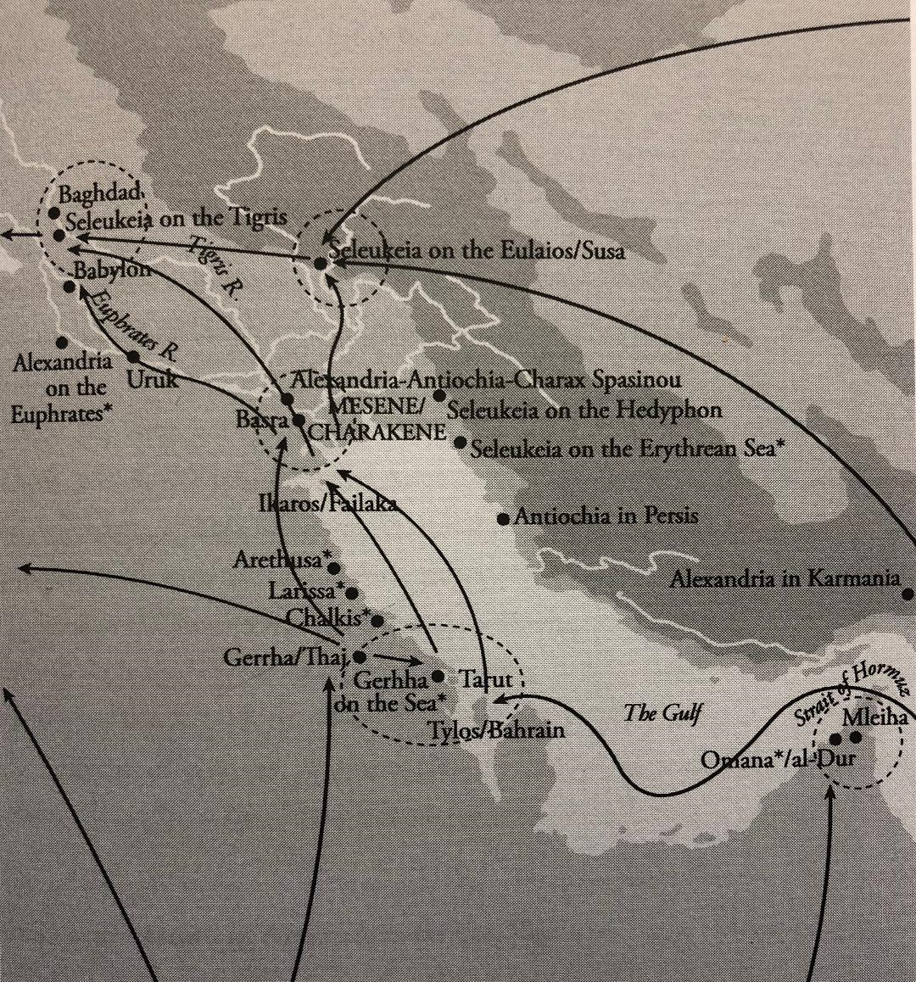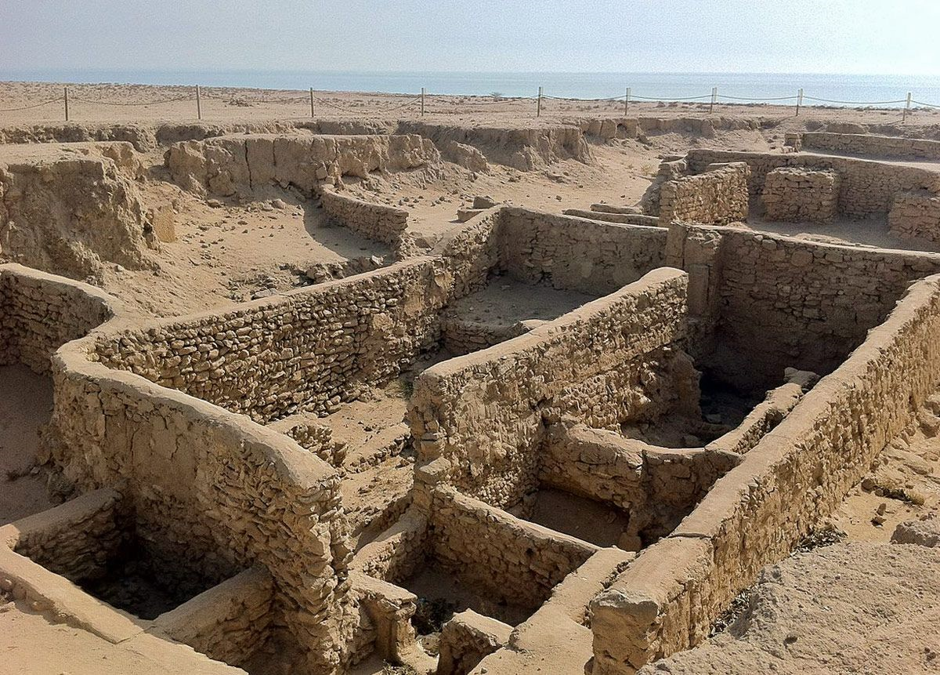Hello again! Having talked about the first royal festival of the Hellenistic period, I’m now going to take a look at one of the most spectacular – not for its size or prestige, but its location, more than 1,000 miles from the Mediterranean. These local contests, held on the island of Failaka at the head of the Persian Gulf, are an excellent example of the use of festivals by Hellenistic rulers to manage their far-flung dominions.

The Persian Gulf in the Hellenistic period, showing major trade routes for South Asian and South Arabian goods. Note that the location, and even the existence, of many of these sites is speculative, and that the head of the Gulf is constantly being filled in by silt from the Tigris and Euphrates – Alexandria/Antiocheia Charax was probably situated on the coastline in this era.
The Persian Gulf was crossed by long-established maritime networks which linked Mesopotamia and southern Iran to southern Arabia and ultimately India, and many pre-Hellenistic states, including the Achaemenid empire, had exerted political influence there in order to benefit from the trade in exotic and luxury goods. The Seleukids proved no exception, as their dedications of incense and spices to Mediterranean temples demonstrate. Building on Alexander’s foundation of a new city, Alexandria Charax, at the head of the Gulf, the third-century kings established a chain of settlements and naval bases stretching at least as far as Bahrain (Greek Tylos), and allowing them to project naval power to the Strait of Hormuz (see Pliny, Natural History VI.28.152).
The small island of Ikaros (modern Failaka) was a link in this chain. Numerous excavations have revealed Hellenistic settlements and sanctuaries on the island, and there are indications of some immigration by Greeks – several potsherds and rough inscriptions in Greek have been found, some of which mention an Athenian, Soteles. Of especial interest to us is a stele discovered near one of the two temples at the evocatively-named Location F5, a fortified sanctuary in the southwest of the island which flourished between c.250 and c.150 BC.
The stele records a letter from a high-ranking Seleukid official, Ikadion, to Anaxarchos, who was probably a governor based at Tylos. After a short covering letter from Anaxarchos to the Ikarians, it reads:
“Ikadion to Anaxarchos. Greetings. The king is concerned about the island of Ikaros, because his forebears also consecrated land there and decided to move the temple of the Saviour Goddess. And they wrote to the officials in charge of the administration (instructing them) to move it. But they, either, [perhaps] because they were prevented, or indeed for some [other] reason did not move it. But we, when the king wrote to us, moved [it? promptly], and we established […] a contest, both / sporting and [musical,] wishing to carry out the policy of the king and of his forebears.”
SEG 20-411, lines 7-20. Translation adapted from Roueché and Sherwin-White (1985).
Unfortunately the inscription becomes extremely fragmentary after this point, but Ikadion seems to be concerned for the status of land, settlements and trade on Ikaros, particularly with regard to the neōkoroi (temple wardens). The Saviour Goddess is almost certainly a local deity known to the Greeks as Artemis Soteira, and mentioned in several other inscriptions. The date of the letter has provoked much controversy, with suggestions ranging throughout the 3rd century BC – some point in the second half of the century seems most plausible, considering the lifespan of the sanctuary as a whole (on this issue, see Hannestad 2019).

The sanctuary at F5.

It is thus impossible to pin down the exact circumstances under which this agōn was introduced to Ikaros. What is clear, however, is that it was intended to bind the islanders together through a communal ritual centred on one of the island’s most important deities. The text later seems to refer to “encroachment” on land, suggesting a conflict over property rights, and to synoikismos, the gathering of scattered people into a single settlement. As a response to social divisions royal officials turned to a competitive festival as a means to foster a cohesive local identity.
What is particularly notable is the form of the festival – an agōn was very much a Greek cultural institution. Yet while there may have been a sizeable Greek population on Ikaros, there is no sign here that this was an event aimed only at them. Rather it was to involve the whole community, presumably including the neōkoroi, who should perhaps be seen as local priestly elites. As we will see many times when looking at Hellenistic festivals, one’s identity as a Greek was less important than one’s ability to engage with Greek culture and perform its rituals. The aim may have been to tie Ikaros to other regional sites with Greek institutions such as Seleukeia on the Tigris and Antiocheia in Persia, both of which are known to have interacted with agōnes in other cities.
Equally important is that the letter presents the movement of the temple and the establishment of the festival as royal policy. Whether this was indeed a personal initiative of the king is unclear, but the truth is less important than the appearance – that these contests were founded in a system of royal oversight stretching back generations to the time of the king’s forebears. This novel institution is rendered not only a link to the Greek world, but a link to the court, a ceremony in which the people of Ikaros themselves invoked an imperial presence in the reshaping of their community. At the same time, it was one which revolved around a local cult, symbol of a local identity which was now bound a little more closely to the Seleukid dynasty.
The concept of “Hellenisation” remains a somewhat controversial one in modern scholarship, and certainly political projects like the Seleukid did not involve any large-scale efforts to impose a Greek identity on subject populations. What we can see here, however, is the selective promotion of a Greek practice – the agonistic festival – as a means to reinforce social cohesion, create connections between an island settlement and the great urban centres of the kingdom, and position a distant community as explicitly Seleukid in its allegiance, pushing royal authority a little further into the expanses of the Indian Ocean.
Tom
Further Reading:
Beaujard, Philippe, The Worlds of the Indian Ocean Vol. I (Berlin, 2019, trans. Tamara Loring, Frances Meadows and Andromeda Tait, originally published 2014), ch. 9.
Hannestad, Lise, “On the Periphery of the Seleucid Kingdom: Failaka Revisited”, in Roland Oetjen (ed.) New Perspectives in Seleucid History, Archaeology and Numismatics (Berlin, 2019), 312-332.
Petropolou, Maria-Zoe, “A Seleukid Settlement on Failaka”, Epigraphica Anatolica 39 (2000), 139-147.
Roueché, Charlotte and Sherwin-White, Susan, “Some Aspects of the Seleucid Empire: The Greek Inscriptions from Failaka, in the Arabian Gulf”, Chiron 15 (1985), 1-39.
